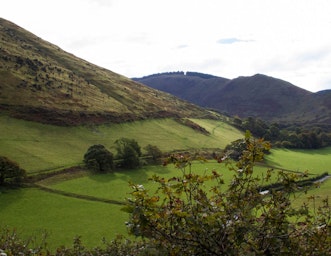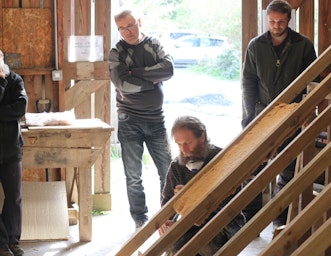
As we enter the second week of COP26 negotiations, Paul Allen looks back on the first week of pledges, announcements and civil society responses, and looks ahead at what needs to happen now.
As week one of COP26 came to an end, I attended an astounding climate justice march across Glasgow. Despite strong winds and heavy rain, around 100,000 people marched to call for rapid action on the climate emergency and a response that has climate justice at its heart. There were over 200 actions and demonstrations in countries across the globe, including Kenya, Turkey, France, Brazil, Australia and Canada.
Fringe events continued over the weekend, with the COP26 Coalition People’s Summit beginning on Sunday platforming voices and topics often unheard in the official negotiations. The Blue and Green Zones of COP26 are now re-opening after a crucial half time break. Throughout the first week, many key speakers in these zones made it clear they know the clock is ticking. But few have recognised that the alarm is now off, and that governments have actually pressed snooze several times!

The story so far…
On Monday and Tuesday of week one, a great many world leaders came to Glasgow to kick off the conference proceedings. Fortunately, unlike previous COPs, the backdrop to this first week of COP26 has been deeply rooted in a much greater awakening to the reality of climate science across wider society. Recent reports by globally respected bodies, such as the recent IPCC report, the UNEP Emissions Gap report, UNEP Production Gap report, and the UNFCCC Synthesis report, clearly spell out the urgent need to raise national ambition to keep 1.5C in reach.
This new call to action from the science meant the first week of COP26 opened with a positive feel. As well as fulfilling our roles as official observers of the negotiations, COP26 offered the CAT team a unique opportunity to share and harvest practical solutions with organisations from across the globe.
CAT’s Innovation Lab Manager Anna Bullen presented on climate leadership at a Welsh Government event in the UK Pavilion, and our Zero Carbon Britain Training Manager Amanda Smith and Head of Development Eileen Kinsman have been building new links with environmental and education networks.
I was honoured to be asked to share how we have used CAT’s Zero Carbon Britain work at an official COP side event. This was deeply moving for me, as I was speaking alongside experts offering solutions from majority world countries such as Tanzania, Sri Lanka and Bangladesh. Seeing real life examples of what can be achieved in countries where daily life is so much harder than it is here in the West was most inspiring, and many thanks to the International Network for Sustainable Energy for arranging the event.
Overall, the first week of COP26 offered some important forward steps:
- The US and the EU announced a global partnership to cut emissions of the greenhouse gas methane by 2030.
- More than 100 world leaders promised to end and reverse deforestation by 2030, including Brazil – where vast stretches of the Amazon rainforest are being destroyed.
- India pledged net zero by 2070, Nigeria by 2060, Vietnam, Thailand, and Kenya by 2050. Nepal moved their net zero date to 2045, and there were lots of new pledges to phase out coal.
- It has become clear that the cost reductions in wind and solar energy technologies have brought them to a tipping point, ready for a global roll-out.
- The finance and business sectors have become more widely and deeply engaged than at any previous COP. Championed by Mark Carney, over 450 firms representing $130 trillion of assets have joined the Glasgow Financial Alliance for Net Zero. However, much of this was quickly dismissed by climate campaign groups as greenwash, as many of the organisations involved still fund fossil fuels.
But as COP26 re-opens for week two today, there is still much work to do. We must, of course, be grateful for increased net zero pledges from majority world countries where resources are scarce, and who are not anywhere near as responsible for the climate emergency as the long-industrialised West. So, to maintain the focus on ambition for the high emitters, we must be rigorous in quantifying how far the half time total of all the pledges actually gets the world towards limiting warming to the vital 1.5C goal.
As week one closed, many media streams reported that, if all fully implemented, the pledges received so far at COP26 could reduce warming from 2.7C to 1.9C or even 1.8C. So I spent Friday afternoon exploring the research behind these claims and visiting a range of climate expert pavilions.
The 1.9C claim originated from the University of Melbourne. The 1.8C claim originated from the International Energy Agency. Clearly this research says pledges to date ‘could help’ rather than ‘will achieve’ 1.8C.

Clearly defining net zero
The key thing to understand about the science of limiting global warming to 1.5C is that it does not solely depend on the date that net zero is reached, but also on the area under the curve – the cumulative amount of carbon released in getting to zero. So, for any new pledges to deliver, what is needed are actions that will genuinely reduce emissions, and the sooner this begins, the greater the impact. There is also a need to ensure the finance and support needed to deliver these goals will be made available.
There is a clear need to differentiate between a ‘genuine net zero transition’, and a ‘speculative net zero transition’, which contains loopholes that allow business as usual to continue. Genuine net zero means the end goal is achieved within the required remaining carbon budget, the finance needed is allocated, and it is achievable without the mass reliance on speculative, unproven and un-costed technologies, which – by not doing what we need to do now – would put the burden on future generations to recapture large amounts of carbon released.
As week two kicks off, the UK presidency must lead ‘Team COP’ through some really difficult challenges, bridging the divide between richer and poorer countries. We need to hear genuine commitments to increased action from the long-industrialised countries. But we also need to be on the lookout of any vague claims that ‘we have got 1.5C done!’ Unless it is clear that there is a genuine net zero transition within the carbon budgets of the high emitting countries, there is much work still to do. The success or failure of this COP will be defined by actions, not words.
About the author
Paul Allen is CAT’s Zero Carbon Britain Knowledge and Outreach Coordinator. He has been involved with our research into net zero scenarios since the beginning, coordinating the development of research reports and liaising directly with government, industry, NGOs and the arts to share findings.
- Zero Carbon Britain
- Climate Change
Related Topics
Related Pages
Related news


CAT Conversations: Sandy Stevens, CAT graduate
17th April 2025
CAT stories – Nick Parsons and Mike Russell
29th January 2025
